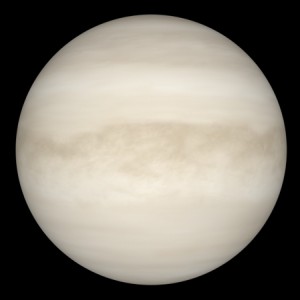
Venus is the second furthest planet from the Sun. It is the nearest planet to Earth and the closest in size. However, it is very different from Earth in many ways.
The surface of Venus is obscured by thick clouds of sulfuric acid which are opaque to visible light and cause acid rain to fall in the upper atmosphere. Below around 25 km above the surface, this acid rain evaporates, leaving a dense but transparent layer consisting mainly of carbon dioxide beneath.
The atmosphere on Venus is so thick that the pressure at the surface is equivalent to the pressure found half a mile under the sea on Earth. Venus is closer to the Sun than the Earth and carbon dioxide is a greenhouse gas, which traps the Sun’s heat, resulting in an average surface temperature of around 460 °C. The first probes sent to Venus were quickly destroyed by the high atmospheric pressure and heat.
Venus Stats:
- Type: Terrestrial
- Diameter: 12,104 km (0.95 Earths)
- Mass: 4.868×1024 kg (0.815 Earths)
- Distance from Sun: 0.728 AU to 0.718 AU
- Sidereal period (day length): 243 Earth days (retrograde)
- Orbital period (year length): 224.7 Earth days or 0.615 years
- Number of Moons: 0
- Symbol: ♀ (HTML code: ♀)
Surface
The Magellan probe, launched in 1989, produced a highly accurately radar map of the surface, from orbit above the clouds, which showed evidence of extensive volcanic activity.
Magellan also discovered a reflective substance on the peaks of high mountains, which is speculated to be metallic “snow” consisting possibly of tellurium or lead sulfide (galena).
Observation
Seen from Earth, Venus is the second brightest object in the night sky, after the Moon, and is so bright that it is often responsible for reported UFO sightings.
Depending on its position relative to the Sun, Venus is often know as the “morning star”, when visible in the early hours of morning, and the “evening star”, when visible in the early evening (personified by the half brothers Phosphorus and Hesperus, respectively, in Greek mythology).
Because, like Mercury, the orbit of Venus is inside that of the Earth, Venus can be observed in transit as it passes across the disc of the Sun. Warning: Never use a telescope or binoculars to look at the Sun without a specially designed solar filter, or by carefully projecting the Sun’s image onto a white screen, and do not look directly at the Sun without wearing eclipse glasses.
Venus also exhibits phases similar to those of the Moon.
Exploration
Venus was the target of the first interplanetary mission – Venera 1. This spacecraft was launched by the Soviet Union on 12 February 1961, but contact was lost before it reached its closest approach of 100,000 km due to an overheated orientation sensor.
In 1962, NASA’s Mariner 2 probe flew within 35,000 km of the planet. This was followed by visits from Mariner 5 in 1967 and Mariner 10 in 1974.
The Soviet Venera 3 became the first space probe to reach the surface of another planet when it crash landed on Venus on 1 March 1966.
Venera 4 visited Venus in 1967 dropping a descent capsule into the atmosphere on 18 October. This was followed by visits from Venera 5 and Venera 6 in May 1969 both of which were crushed by the high atmospheric pressure around 18 km from the surface.
On 15 December 1970, Venera 7 became the first probe to successfully land on the surface of Venus without crashing or being destroyed by the harsh atmospheric conditions.
To find the current position of Venus in the sky from your location, visit our Night Sky Simulator.